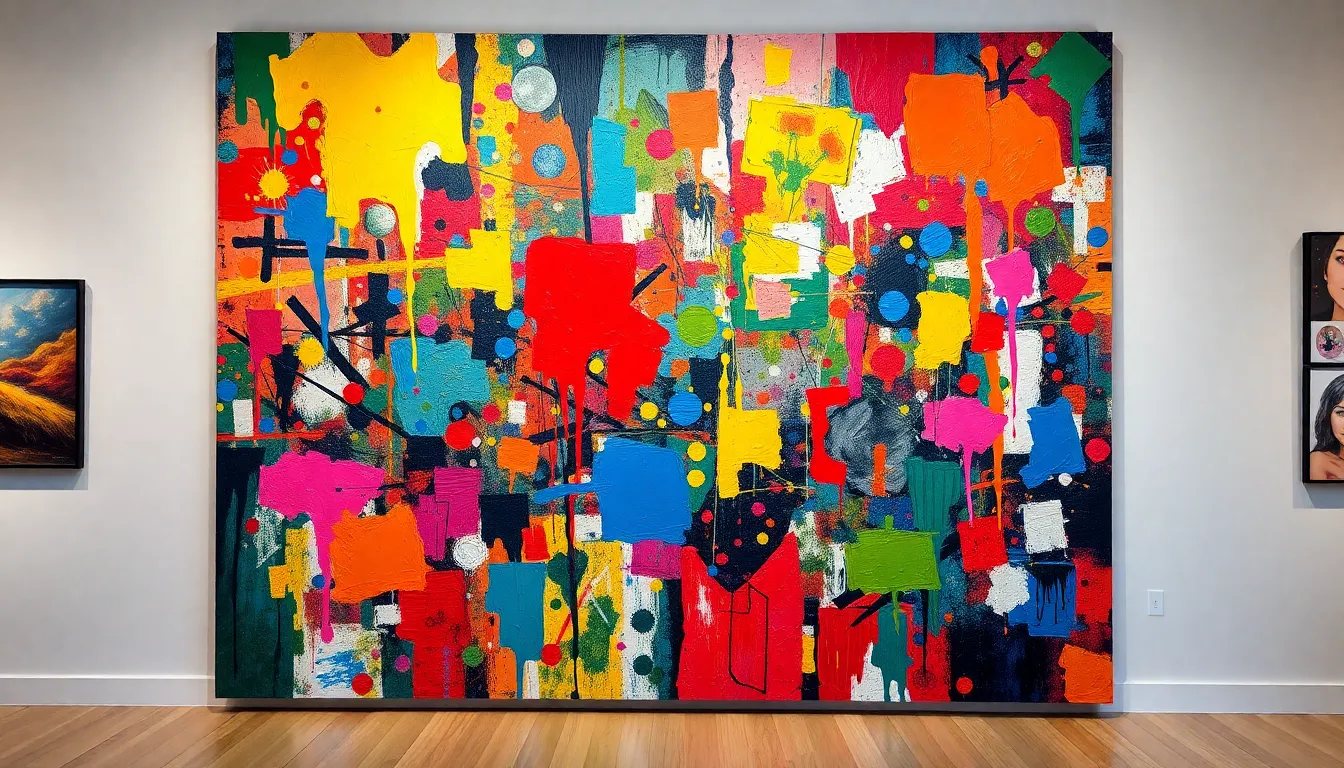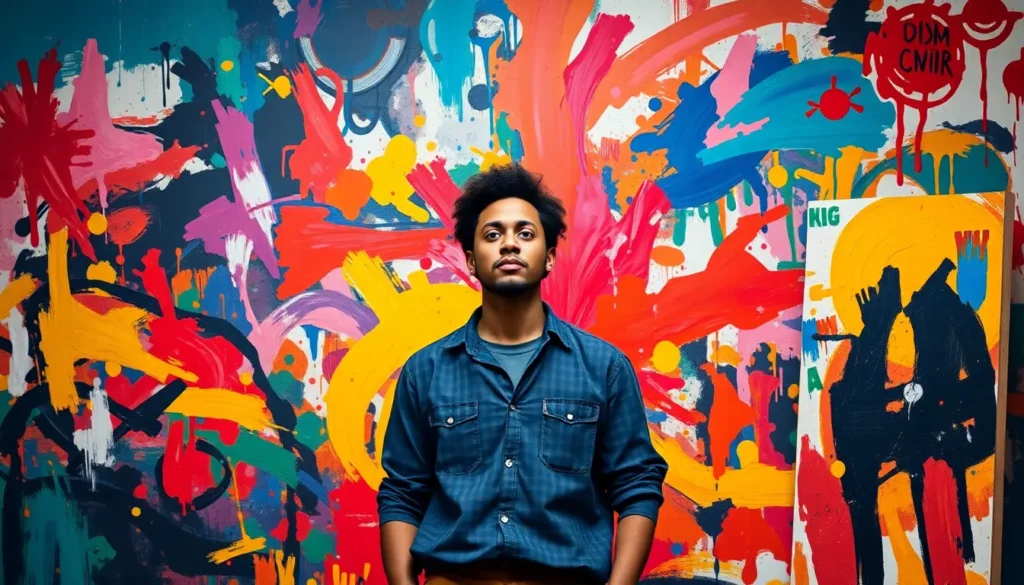In the wild world of art, Neo-Expressionism bursts onto the scene like a brightly colored piñata at a black-tie gala. This movement, which emerged in the late 20th century, takes the emotional intensity of Expressionism and cranks it up to eleven. With bold colors and raw, often chaotic forms, artists dive deep into the human experience, revealing feelings that might just make you laugh, cry, or question your life choices.
But don’t be fooled by its playful exterior—Neo-Expressionism is serious business. It challenges conventions and invites viewers to confront their own emotions. Whether it’s a riotous canvas or a sculptural masterpiece, this movement has something for everyone. So grab your favorite beverage and prepare to explore the vibrant, sometimes outrageous world of Neo-Expressionism, where art isn’t just seen; it’s felt in the very core of one’s being.
Table of Contents
ToggleOverview of Neo-Expressionism
Neo-Expressionism emerged in the late 20th century, embodying emotional intensity and chaotic forms. This movement invites viewers to engage with art on a deeper emotional level.
Historical Context
Emerging in the late 1970s and peaking in the 1980s, Neo-Expressionism responded to the minimalist and conceptual art trends of preceding decades. Artists sought to reintegrate emotion into their work, breaking free from sterile forms. Many artists drew inspiration from post-war experiences, exploring themes such as trauma and identity. Key figures, including Julian Schnabel and Anselm Kiefer, contributed to shaping the movement, aligning themselves with broader cultural shifts. This period also reflected societal unrest and political turbulence, influencing the raw and visceral qualities of the art.
Key Characteristics
Neo-Expressionism showcases bold colors and dynamic forms, emphasizing emotional expression over realism. Artists often used dramatic brushstrokes and unconventional materials to create texture and depth. Frequently, the subject matter is deeply personal, reflecting individual experiences or societal issues. Many pieces contain elements of abstraction combined with figuration, inviting interpretation. This movement’s sense of urgency resonates through its rejection of traditional aesthetics, positioning Neo-Expressionism as a vital counterpart to its minimalist predecessors.
Prominent Artists in Neo-Expressionism

Several artists stand out in the Neo-Expressionism movement, each contributing their unique styles and perspectives. These creators challenged traditional norms through emotional and vivid artwork.
Anselm Kiefer
Anselm Kiefer is known for his large-scale paintings and installations that explore themes of memory, history, and identity. His work often incorporates unconventional materials, including ash, straw, and lead, emphasizing the weight of historical trauma. Kiefer’s use of dark colors and heavy textures evokes a sense of depth and complexity, compelling viewers to confront uncomfortable truths. Relevant works, such as “The Breaking of the Vessels,” highlight his engagement with mythology and philosophy, demonstrating the interplay between personal and collective experiences. Kiefer’s approach profoundly impacts the understanding of post-war Europe, illustrating the struggle between past and present.
Julian Schnabel
Julian Schnabel is recognized for his innovative techniques that blend painting, collage, and sculpture. His signature style features bold brushwork and striking colors that capture emotional intensity. Schnabel’s notable works, such as “The Sea and Its […]
Reflections,” exhibit a combination of abstraction and figurative elements, engaging viewers with a raw, emotional narrative. Known also for his contributions to film, he expands the boundaries of Neo-Expressionism beyond canvas. Each piece invites individual interpretation, fostering an intimate dialogue between the artwork and observer. Schnabel’s approach embodies the spirit of the movement, emphasizing personal expression and challenging the viewer’s perception of art.
Themes and Motifs in Neo-Expressionism
Neo-Expressionism explores themes that resonate deeply with human emotions and societal issues. Emotional intensity and political commentary frequently emerge as key components of this movement.
Emotional Intensity
Emotional intensity stands at the core of Neo-Expressionism, where artists express raw feelings. Bold colors and dynamic forms create visual impact and evoke visceral reactions. Experience informs each work, as artists draw from personal and collective traumas. The resulting imagery often reflects internal struggles and existential questions. For instance, the use of dramatic brushstrokes conveys urgency and passion, allowing viewers to engage with their own emotions. Through abstract interpretations and recognizable figures, this movement encourages profound reflection and dialogue.
Political Commentary
Political commentary plays a crucial role in Neo-Expressionism. Artists often address societal unrest and historical events through their artwork. Themes of war, identity, and oppression manifest vividly in their creations. Mixed media and unconventional materials emphasize these urgent topics, reinforcing the relationship between art and activism. Anselm Kiefer’s diverse materials symbolize the weight of history, while Julian Schnabel’s striking imagery critiques contemporary issues. This art movement doesn’t shy away from challenging norms, inviting observers to confront discomforting realities and inciting conversations about power dynamics.
Impact on Contemporary Art
Neo-Expressionism profoundly influenced contemporary art, reshaping artistic practices and philosophies. The movement’s emphasis on emotional expression and personal narratives resonates with many modern artists, inspiring them to explore similar themes in their work.
Influence on Future Movements
Artists in subsequent movements, such as Street Art and contemporary figurative painting, draw inspiration from Neo-Expressionism’s emotional intensity. Themes of identity, trauma, and social commentary remain pivotal, encouraging innovative exploration within modern artworks. Furthermore, young artists often experiment with mixed media, blending traditional techniques with contemporary practices, reflecting the boldness of Neo-Expressionism. Thus, the movement catalyzed a broader conversation about the role of emotion and personal experience in art.
Reception in the Art World
Critics and collectors responded enthusiastically to Neo-Expressionism during its peak, recognizing its challenge to established norms. Many praised the movement for its vibrant aesthetic and its ability to provoke discussions around sensitive topics. Today, major institutions feature Neo-Expressionist works in exhibitions, underscoring their significance in art history. Artists like Kiefer and Schnabel earned praise for their innovative approaches, solidifying their positions within the art community. The movement continues to attract attention, celebrating its impact on contemporary artistic dialogue.
Neo-Expressionism remains a vital force in the art world, celebrated for its ability to evoke emotion and challenge viewers’ perceptions. The movement’s bold aesthetic and focus on personal narratives continue to inspire contemporary artists seeking to explore themes of identity and trauma. As the legacy of artists like Anselm Kiefer and Julian Schnabel endures, Neo-Expressionism invites ongoing dialogue about the role of emotion in art. Its impact is evident in modern artistic practices that prioritize visceral experiences and social commentary, ensuring that this dynamic movement will resonate for years to come.



